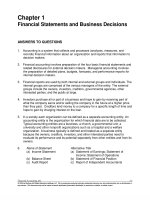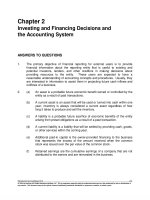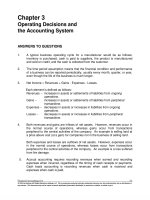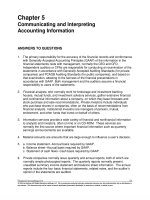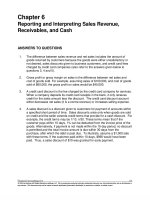Solution manual managerial accounting 8e by hansen mowen ch 4
Bạn đang xem bản rút gọn của tài liệu. Xem và tải ngay bản đầy đủ của tài liệu tại đây (225.42 KB, 34 trang )
To download more slides, ebook, solutions and test bank, visit
CHAPTER 4
ACTIVITY-BASED PRODUCT COSTING
QUESTIONS FOR WRITING AND DISCUSSION
1. Unit costs provide essential information
needed for inventory valuation and preparation of income statements. Knowing unit
costs is also critical for many decisions such
as bidding decisions and accept-or-reject
special order decisions.
represent a significant proportion of total
overhead costs.
8. Low-volume products may consume nonunit-level overhead activities in much greater
proportions than indicated by a unit-level
cost driver and vice versa for high-volume
products. If so, then the low-volume products will receive too little overhead and the
high-volume products too much.
2. Cost measurement is determining the dollar
amounts associated with resources used in
production. Cost assignment is associating
the dollar amounts, once measured, with
units produced.
9. If some products are undercosted and others are overcosted, a firm can make a number of competitively bad decisions. For example, the firm might select the wrong
product mix or submit distorted bids.
3. An actual overhead rate is rarely used because of problems with accuracy and timeliness. Waiting until the end of the year to ensure accuracy is rejected because of the
need to have timely information. Timeliness
of information based on actual overhead
costs runs into difficulty (accuracy problems)
because overhead is incurred nonuniformly
and because production also may be nonuniform.
4. For plantwide rates, overhead is first collected in a plantwide pool, using direct tracing. Next, an overhead rate is computed and
used to assign overhead to products.
5. First stage: Overhead is assigned to production department pools using direct tracing,
driver tracing, and allocation. Second stage:
Individual departmental rates are used to
assign overhead to products as they pass
through the departments.
10.
Nonunit-level overhead activities are those
overhead activities that are not highly correlated with production volume measures. Examples include setups, material handling,
and inspection. Nonunit-level cost drivers
are causal factors — factors that explain the
consumption of nonunit-level overhead. Examples include setup hours, number of
moves, and hours of inspection.
11.
Product diversity is present whenever products have different consumption ratios for
different overhead activities.
12.
An overhead consumption ratio measures
the proportion of an overhead activity consumed by a product.
13.
Departmental rates typically use unit-level
cost drivers. If products consume nonunitlevel overhead activities in different proportions than those of unit-level measures, then
it is possible for departmental rates to move
even further away from the true consumption ratios, since the departmental unit-level
ratios usually differ from the one used at the
plant level.
14.
Agree. Prime costs can be assigned using
direct tracing and so do not cause cost distortions. Overhead costs, however, are not
directly attributable and can cause distortions. For example, using unit-level activity
drivers to trace nonunit-level overhead costs
would cause distortions.
6. Departmental rates would be chosen over
plantwide rates whenever some departments are more overhead intensive than
others and if certain products spend more
time in some departments than they do in
others.
7. Plantwide overhead rates assign overhead
to products in proportion to the amount of
the unit-level cost driver used. If the products consume some overhead activities in
different proportions than those assigned
by the unit-level cost driver, then cost distortions can occur (the product diversity
factor). These distortions can be significant
if the nonunit-level overhead costs
75
To download more slides, ebook, solutions and test bank, visit
ties are those that are performed each time a
batch of products is produced. Product-level
or sustaining activities are those that are
performed as needed to support the various
products produced by a company. Facilitylevel activities are those that sustain a factory’s general manufacturing process
15. Activity-based product costing is an overhead costing approach that first assigns
costs to activities and then to products. The
assignment is made possible through the
identification of activities, their costs, and the
use of cost drivers.
16. An activity dictionary is a list of activities
accompanied by information that describes
each activity (called attributes)
20. Rates can be reduced by building a system
that approximates the cost assignments of a
fully specified ABC system. One way to do
this is by using only the most expensive activities to assign costs. If the most expensive
activities represent a large percentage of the
total costs, then most of the costs are assigned using a cause-and-effect relationship, thus creating a good level of accuracy
while reducing the complexity of the ABC
system.
17. A primary activity is consumed by the final
cost objects such as products and customers, whereas secondary activities are consumed by other activities (ultimately consumed by primary activities).
18. Costs are assigned using direct tracing and
resource drivers.
19. Unit-level activities are those that occur each
time a product is produced. Batch-level activi-
76
To download more slides, ebook, solutions and test bank, visit
EXERCISES
4–1
1.
Units produced
Prime costs
Overhead costs
Unit cost:
Prime
Overhead
Total
Quarter 1 Quarter 2 Quarter 3
Quarter 4
Total
400,000
160,000
80,000
560,000
1,200,000
$8,000,000 $3,200,000 $1,600,000 $11,200,000 $24,000,000
$3,200,000 $2,400,000 $3,600,000 $2,800,000 $12,000,000
$20
8
$28
$20
15
$35
$20
45
$65
$20
5
$25
$20
10
$30
2.
Actual costing can produce wide swings in the overhead cost per unit. The
cause appears to be nonuniform incurrence of overhead and nonuniform
production (seasonal production is a possibility).
3.
First, calculate a predetermined rate:
OH rate = $11,640,000/1,200,000
= $9.70 per unit
This rate is used to assign overhead to the product throughout the year.
Since the driver is units produced, $9.70 would be assigned to each unit. Adding this to the actual prime costs produces a unit cost under normal costing:
Unit cost = $9.70 + $20.00 = $29.70
This cost is close to the actual annual cost of $30.00.
77
To download more slides, ebook, solutions and test bank, visit
4–2
1.
$27,000,000/90,000 = $300 per direct labor hour (DLH)
2.
$300 × 91,000 = $27,300,000
3.
Applied overhead
Actual overhead
Overrapplied overhead
4.
Predetermined rates allow the calculation of unit costs and avoid the problems of nonuniform overhead incurrence and nonuniform production associated with actual overhead rates. Unit cost information is needed throughout
the year for a variety of managerial purposes.
$ 27,300,000
27,200,000
$ 100,000
4–3
1.
Predetermined overhead rate = $4,500,000/600,000 = $7.50 per DLH
2.
Applied overhead = $7.50 × 585,000 = $4,387,500
3.
Applied overhead
Actual overhead
Underapplied overhead
4.
Unit cost:
Prime costs
Overhead costs
Total
Units
Unit cost
$ 4,387,500
4,466,250
$ (78,750)
$ 6,750,000
4,387,500
$ 11,137,500
÷
750,000
$
14.85
78
To download more slides, ebook, solutions and test bank, visit
4–4
1.
Predetermined overhead rate = $4,500,000/187,500 = $24 per machine hour
(MHr)
2.
Applied overhead = $24 × 187,875 = $4,509,000
3.
Applied overhead
Actual overhead
Overapplied overhead
4.
Unit cost:
Prime costs
Overhead costs
Total
Units
Unit cost
$ 4,509,000
4,466,250
$
42,750
$ 6,750,000
4,509,000
$ 11,259,000
÷
750,000
$
15.01*
*Rounded
5.
Gandars needs to determine what causes its overhead. Is it primarily labor
driven (e.g., composed predominantly of fringe benefits, indirect labor, and
personnel costs), or is it machine oriented (e.g., composed of depreciation on
machinery, utilities, and maintenance)? It is impossible for a decision to be
made on the basis of the information given in this exercise.
79
To download more slides, ebook, solutions and test bank, visit
4–5
1.
Predetermined rates:
Drilling Department:
Rate = $600,000/280,000 = $2.14* per MHr
Assembly Department: Rate = $392,000/200,000
= $1.96 per DLH
*Rounded
2.
Applied overhead:
Drilling Department: $2.14 × 288,000 = $616,320
Assembly Department: $1.96 × 196,000 = $384,160
Overhead variances:
Actual overhead
Applied overhead
Overhead variance
3.
Drilling
$602,000
616,320
$ (14,320) over
Assembly
$ 412,000
384,160
$ 27,840 under
Unit overhead cost = [($2.14 × 4,000) + ($1.96 × 1,600)]/8,000
= $11,696/8,000
= $1.46*
*Rounded
80
Total
$ 1,014,000
1,000,480
$13,520 under
To download more slides, ebook, solutions and test bank, visit
4–6
1.
Activity rates:
Machining = $632,000/300,000
= $2.11* per MHr
Inspection = $360,000/12,000
= $30 per inspection hour
*Rounded
Unit overhead cost = [($2.11 × 4,000) + ($30 × 800)]/8,000
= $32,440/8,000
= $4.055
2.
4–7
1.
Inspection hours
Setup hours
Machine hours
Number of moves
Scented Cards
0.20a
0.50b
0.25c
0.75d
Regular Cards
0.80a
0.50b
0.75c
0.25d
a.
Total inspection hours = 200 (40+160); 40/200 for Scented and 160/200 for Regular
b.
Total Setup hours = 100 (50+50); 50/100 for Scented and 50/100 for Regular
c.
Total Machine hours = 800 (200+600); 200/800 for Scented and 600/800 for Regular
d.
Total Number of moves = 300 (225+75); 225/300 for Scented and 75/300 for Regular
2. The consumption ratios vary significantly from driver to driver. Using, for example, only machine hours to assign the overhead may create accuracy problems. Both setup hours and number of moves have markedly different consumption ratios.
4–8
1. Rates:
Inspecting products: $2,000/200 = $10 per inspection hour
Setting up equipment: $2,500/100 = $25 per setup hour
Machining: $4,000/800 = $5 per machine hour
Moving materials: $900/300 = $3.00 per move
Note: The denominator is the total driver amount (sum of the demand of the two
products).
81
To download more slides, ebook, solutions and test bank, visit
2.
Rate = Cost/hours
Inspection hours = Cost/Rate = $2,000/$20 = 100 inspection hours
4–9
1.
Normal
Treating patients:
$4.00 × 5,000
$4.00 × 20,000
Providing hygienic care:
$5.00 × 5,000
$5.00 × 11,000
Responding to requests:
$2.00 × 30,000
$2.00 × 50,000
Monitoring patients:
$0.75 × 20,000
$0.75 × 180,000
Cost Assigned
Intensive
$ 20,000
$ 80,000
25,000
55,000
60,000
100,000
15,000
135,000
$370,000
$120,000
2. Nursing cost per patient day:
$120,000/10,000
$370,000/8,000
Normal
$12.00
Intensive
$46.25
4–10
1. Yes. Because direct materials and direct labor are directly traceable to
each product, their cost assignment should be accurate.
2. The consumption ratios for each (using machine hours and setup hours
as the activity drivers) are as follows:
Machining
Setups
3.
Elegant
0.10
0.50
Fina
0.90 (500/5,000 and 4,500/5,000)
0.50 (100/200 and 100/200)
Elegant: (1.75 × $9,000)/3,000 = $5.25 per briefcase
82
To download more slides, ebook, solutions and test bank, visit
Fina:
(1.75 × $3,000)/3,000 = $1.75 per briefcase
Note: Overhead rate = $21,000/$12,000 = $1.75 per direct labor dollar
(or 175 percent of direct labor cost).
There are more machine and setup costs assigned to Elegant than Fina.
This is clearly a distortion because the production of Fina is automated
and uses the machine resources much more than the handcrafted Elegant. In fact, the consumption ratio for machining is 0.10 and 0.90 (using machine hours as the measure of usage). Thus, Fina uses 9 times
the machining resources as Elegant. Setup costs are similarly distorted. The products use an equal number of setup hours. Yet if direct
labor dollars are used, then the Elegant briefcase receives three times
more machining costs than the Fina briefcase.
4.
Products tend to make different demands on overhead activities and
this should be reflected in overhead cost assignments. Usually this
means the use of both unit and nonunit-level activity drivers. In this example, there is a unit-level activity (machining) and a nonunit-level
activity (setting up equipment).
Machine rate: $18,000/5,000 = $3.60 per machine hour
Setup rate:
$3,000/200 = $15 per setup hour
Costs assigned to each product:
Machining:
$3.60 × 500
$3.60 × 4,500
Setups:
$15 × 100
Total
Units
Unit overhead cost
Elegant
$ 1,800
Fina
$16,200
1,500
$ 3,300
÷ 3,000
$ 1.10
83
1,500
$17,700
÷ 3,000
$ 5.90
To download more slides, ebook, solutions and test bank, visit
4-11
1.
Resource
Equipment
Fuel
Operating
Labor*
Total
Unloading Counting Inspecting
$12,000
$ 800
2,400
1,000
500
48,000
30,000
42,000
$30,000
$43,300
$63,400
*(0.40 × $120,000; 0.25 × $120,000; 0.35 × $120,000)
2. Direct tracing and driver tracing are used. When the resource is used only by
one activity, then direct tracing is possible. When the activities are shared, as in
the case of labor, then resource drivers must be used.
4–12
Activity dictionary:
Activity
Name
Activity
Description
Primary/
Secondary
Activity
Driver
Providing nursing
care
Satisfying patient
needs
Primary
Nursing hours
Supervising
nurses
Coordinating
nursing activities
Secondary
Number of nurses
Feeding patients
Providing meals
to patients
Primary
Number of meals
Laundering
bedding and
clothes
Cleaning and
delivering clothes
and bedding
Primary
Pounds of laundry
Providing
physical
therapy
Therapy treatments
directed by
physician
Primary
Hours of therapy
Monitoring
patients
Using equipment to
monitor patient
conditions
Primary
Monitoring hours
84
To download more slides, ebook, solutions and test bank, visit
4–13
1.
Cost of labor (0.40 × $50,000)
Forklift (direct tracing)
Total cost of receiving
$20,000
10,000
$30,000
2.
Activity rates:
Receiving:
Setup:
Grinding:
Inspecting:
$30,000/60,000 = $0.50 per part
$60,000/300 = $200 per setup
$90,000/18,000 = $5 per MHr
$20,000/2,000 = $10 per inspection
Subassembly A
Overhead:
Setup:
$200 × 150
$200 × 150
Inspecting:
$10 × 1,500
$10 × 500
Grinding:
$5 × 7,200
$5 × 10,800
Receiving:
$0.50 × 20,000
$0.50 × 40,000
Total costs assigned
3.
Subassembly B
$ 30,000
$ 30,000
15,000
5,000
36,000
54,000
10,000
$91,000
20,000
$109,000
Setup pool: $60,000 + [($60,000/$150,000) × $50,000] = $80,000
Grinding pool: $90,000 + [($90,000/$150,000) × $50,000] = $120,000
Pool rates:
Setup = $80,000/300
= $266.67/setup
Grinding = $120,000/18,000
= $6.67/ Mhr
85
To download more slides, ebook, solutions and test bank, visit
Approximating assignment:
Subassembly A
Setup:
$266.67 × 150
$266.67 × 150
Grinding:
$6.67 × 7,200
$6.67 × 10,800
Total costs assigned
4.
Subassembly B
$40,000
$ 40,000
48,024
$88,024
72,036
$112,036
Error (Subassembly A) = ($91,000 - $88,024)/$91,000 = 0.033
Error (Subassembly B) = ($109,000 - $112,036)/$109,000 = - 0.028
The error is small and so the approach may be desirable as it reduces the
complexity and size of the system, making it more likely to be accepted by
management.
4–14
1.
Unit-level activities:
Batch-level activities:
Product-level activities:
Facility-level activities:
Machining
Setups and packing
Receiving
None
2.
Activity rates:
(1) Machining: $80,000/40,000 = $2 per MHr
(2) Setups: $32,000/400 = $80 per setup
(3) Receiving: $18,000/600 = $30 per receiving order
(4) Packing: $48,000/3,200 = $15 per packing order
Overhead assignment:
Infantry
Activity 1: $2 × 20,000 = $ 40,000
Activity 2: $80 × 300 =
24,000
Activity 3: $30 × 200 =
6,000
Activity 4: $15 × 2,400 =
36,000
Total
$106,000
86
To download more slides, ebook, solutions and test bank, visit
Special forces
Activity 1: $2 × 20,000 =
Activity 2: $80 × 100 =
Activity 3: $30 × 400 =
Activity 4: $15 × 800 =
Total
$ 40,000
8,000
12,000
12,000
$ 72,000
Combining Activities 2 and 4 produces a new pooled rate:
($32,000 +$48,000)/400 = $ 200 per setup
Overhead assignment:
Infantry
Activity 1: $2 × 20,000 = $ 40,000
Activity 2*: $200 × 300 =
60,000
Activity 3: $30 × 200 =
6,000
Total
$106,000
*Combined activities 2 and 4
Special forces
Activity 1: $2 × 20,000 =
Activity 2: $200× 100 =
Activity 3: $30 × 400 =
Total
$ 40,000
20,000
12,000
$ 72,000
The assignments are the same and this happens because the consumption ratios of activities 2 and 4 are identical. Thus, rate reduction can
occur by combining all activities with identical rates.
3. The two most expensive activities are the first and the combined 2 and 4
activities. Each has $80,000 of cost. Thus if the cost of activity 3 is allocated in proportion to the cost, each of the expensive activities would
receive 50% of the $18,000 or $9,000. This yields the following pool
rates:
Activity (pool 1) 1: ($80,000 + $9,000)/40,000 = $2.225 per machine hour
Activities 2 and 4 (pool 2): ($80,000 + $9,000)/400 = $222.50 per setup
87
To download more slides, ebook, solutions and test bank, visit
Overhead assignment:
Infantry
Pool 1: $2.225 × 20,000 = $ 44,500
Pool 2: $222.50 × 300 =
66,750
Total
$111,250
Special forces
Pool 1: $2.225 × 20,000 = $ 44,500
Pool 2: $222.5 × 100 =
22,250
Total
$ 66,750
4. Infantry: ($111,250 - $106,000)/$106,000 = .05 (rounded)
Special forces = ($66,750 - $72,000)/$72,000 = -.07 (rounded)
The error is less than 10% for both products. Using machine hours
would have produce a rate of $178,000/40,000 = $4.45 per Mhr and an
assignment of $89,000 to each product ($4.45 × 20,000). The error for
the plantwide rate would be
Infantry: ($89,000 - $106,000)/106,000 = 0.16 (rounded)
Special forces = ($89,000 - $72,000)/$72,000 = 0.24 (rounded)
Thus, the plantwide rate produces product costing errors that are more
than three times the magnitude of the approximately relevant ABC assignments. Clearly, the approximation produces a more reasonable and
useful outcome and is less complex than the full ABC system.
4–15
1.
Unit-level:
Testing products, inserting dies
2.
Batch-level:
Setting up batches, handling wafer lots, purchasing
materials, receiving materials
3.
Product-level: Developing test programs, making probe cards,
engineering design, paying suppliers
4.
Facility-level:
Providing utilities, providing space
88
To download more slides, ebook, solutions and test bank, visit
PROBLEMS
4–16
1.
Cost before addition of duffel bags:
$60,000/100,000 = $0.60 per unit
The assignment is accurate because all costs belong to one product.
2.
Activity-based cost assignment:
Stage 1:
Activity rate = $120,000/80,000 = $1.50 per transaction
Stage 2:
Overhead applied:
Backpacks: $1.50 × 40,000* = $60,000
Duffel bags: $1.50 × 40,000 = $60,000
*80,000 transactions/2 = 40,000 (number of transactions had
doubled)
Unit cost:
Backpacks: $60,000/100,000 = $0.60 per unit
Duffel bags: $60,000/25,000 = $2.40 per unit
3.
Product cost assignment:
Overhead rates:
Patterns: $48,000/10,000 = $4.80 per direct labor hour
Finishing: $72,000/20,000 = $3.60 per direct labor hour
89
To download more slides, ebook, solutions and test bank, visit
Unit cost computation:
Backpacks
Patterns:
$4.80 × 0.1
$4.80 × 0.4
Finishing:
$3.60 × 0.2
$3.60 × 0.8
Total per unit
4.
Duffel Bags
$0.48
$1.92
0.72
2.88
$1.20
$4.80
This problem allows us to see what the accounting cost per unit should
be by providing the ability to calculate the cost with and without the
duffel bags. With this perspective, it becomes easy to see the benefits
of the activity-based approach over those of the functional-based approach. The activity-based approach provides the same cost per unit as
the single-product setting. The functional-based approach used transactions to allocate accounting costs to each producing department,
and this allocation probably reflects quite well the consumption of accounting costs by each producing department. The problem is the
second-stage allocation. Direct labor hours do not capture the consumption pattern of the individual products as they pass through the
departments. The distortion occurs, not in using transactions to assign
accounting costs to departments, but in using direct labor hours to assign these costs to the two products.
In a single-product environment, ABC offers no improvement in product-costing accuracy. However, even in a single-product environment,
it may be possible to increase the accuracy of cost assignments to other cost objects such as customers.
4–17
1. Plantwide rate = $1,320,000/440,000 = $3.00 per DLH
Overhead cost per unit:
Model A: $3.00 × 140,000/30,000 = $14.00
Model B: $3.00 × 300,000/300,000 = $3.00
90
To download more slides, ebook, solutions and test bank, visit
2. Calculation of activity rates:
Activity
Setup
Inspection
Machining
Maintenance
Driver
Prod. runs
Insp. hours
Mach. Hours
Maint. hours
Activity Rate
$360,000/100 = $3,600 per run
$280,000/2,000 = $140 per hour
$320,000/220,000 = $1.454 per hr
$360,000/100,000 =$3.60 per hr
Overhead assignment:
Model A
Setups
$3,600 × 40
$3,600 × 60
Inspections
Model B
$ 144,000
$216,000
$140 × 800
112,000
$140 × 1,200
Machining
$1.454 × 20,000
$1.454 × 200,000
Maintenance
$3.60 × 10,000
$3.60 × 90,000
Total overhead
Units produced
Overhead per unit
3.
168,000
29,080
290,800
36,000
----$321,080
÷ 30,000
324,000
$998,800
÷300,000
$
$
10.70
3.33
Departmental rates:
Overhead cost per unit:
Model A: [($4.66 × 10,000) + ($1.20 × 130,000)]/30,000 = $6.76
Model B: [($4.66 × 170,000) + ($1.20 × 270,000)]/300,000 = $3.72
4.
A common justification is that of using machine hours for machineintensive departments and labor hours for labor-intensive departments.
Using activity-based costs as the standard, we can say that departmental rates decreased the accuracy of the overhead cost assignment (over
91
To download more slides, ebook, solutions and test bank, visit
the plantwide rate) for both products. Looking at Department 1, this department’s costs are assigned at a 17:1 ratio which overcosts B and
undercosts A in a big way. This raises some doubt about the conventional wisdom regarding departmental rates.
4–18
1.
Labor and gasoline are driver tracing.
Labor (0.75 × $180,000)
Gasoline ($4.50 × 6,000 moves)
Depreciation
Total cost
2.
3.
$ 135,000 Time = Resource driver
27,000 Moves = Resource driver
18,000 Direct tracing
$180,000
Plantwide rate = $660,000/20,000
= $33 per DLH
Unit cost:
Basic
Prime costs
$160.00
Overhead:
$33 × 10,000/40,000
8.25
$33 × 10,000/20,000
$168.25
Deluxe
$320.00
16.50
$336.50
Activity rates:
Maintenance
Engineering
Material handling
Setting up
$114,000/4,000 = $28.50 per maint. hour
$120,000/6,000 = $20 per eng. hour
$180,000/6,000 = $30 per move
$ 96,000/80 = $1,200 per move
Purchasing
$ 60,000/300 = $200 per requisition
Receiving
Paying suppliers
$ 40,000/750 = $53.33 per order
$ 30,000/750 = $40 per invoice
Providing space
$ 20,000/10,000 = $2.00 per machine hour
92
To download more slides, ebook, solutions and test bank, visit
4-18 (continued)
Unit cost:
Prime costs
Overhead:
Maintenance
$28.50 × 1,000
$28.50 × 3,000
Engineering
$20 × 1,500
$20 × 4,500
Material Handling
$30 × 1,200
$30 × 4,800
Setting up
$1,200 × 16
$1,200 × 64
Purchasing
$200 × 100
$200 × 200
Receiving
$53.33 × 250
$53.33 × 500
Paying Suppliers
$40 × 250
$40 × 500
Providing space
$2 × 5,000
$2 × 5,000
Total
Units produced
Unit cost (ABC)
Unit cost (traditional)
Basic
$6,400,000
Deluxe
$6,400,000
28,500
85,500
30,000
90,000
36,000
144,000
19,200
76,800
20,000
40,000
13,333
26,665
10,000
20,000
10,000
$6,567,033
÷ 40,000
$
164.18
$
168.25
10,000
$6,892,965
÷ 20,000
$ 344.65
$ 336.50
The ABC costs are more accurate (better tracing—closer representation of actual resource consumption). This shows that the basic model
was overcosted and the deluxe model undercosted when the plantwide
overhead rate was used.
93
To download more slides, ebook, solutions and test bank, visit
4-18 (continued)
4. Consumption ratios:
Maint. Eng. Mat. H. Setups Purch. Receiving Pay. Sup Space
5.
Basic 0.25
0.25
0.20
0.20
0.33
0.33
0.33
0.50
Delux 0.75
0.75
0.80
0.80
0.67
0.67
0.67
0.50
When products consume activities in the same proportion, the activities with the same proportions can be combined into one pool. This is
so because the pooled costs will be assigned in the same proportion as
the individual activity costs.
Using these consumption ratios as a
guide, we create four pools, reducing the number of rates from 8 to 4.
Pool 1:
Maintenance
Engineering
Total
Maintenance hours
Pool rate
$114,000
120,000
$234,000
÷ 4,000
$ 58.50
Note: Engineering hours could also be used as a driver. The activities
are grouped together because they have the same consumption ratios:
(0.25, 0.75).
Pool 2: Material handling
Setting up
Total
Number of moves
Pool rate
$180,000
96,000
$276,000
÷ 6,000
$
46
Note: Material handling and setups have the same consumption ratios:
(0.20, 0.80). The number of setups could also be used as the pool driver.
94
To download more slides, ebook, solutions and test bank, visit
4-18 (concluded)
Pool 4: Purchasing
Receiving
Paying suppliers
Total
Orders processed
Pool rate
$ 60,000
40,000
30,000
$130,000
÷
750
$ 173.33
Note: The three activities are all product-level activities and have the
same consumption ratios: (0.33, 0.67)
Pool 5: Providing space
Machine hours
Pool rate
$ 20,000
÷ 10,000
$
2
Note: This is the only facility-level activity.
4–19
1.
Unit-level costs ($120 × 20,000)
Batch-level costs ($80,000 × 20)
Product-level costs ($80,000 × 10)
Facility-level ($20 × 20,000)
Total cost
$ 2,400,000
1,600,000
800,000
400,000
$ 5,200,000
2.
Unit-level costs ($120 × 30,000)
Batch-level costs ($80,000 × 20)
Product-level costs ($80,000 × 10)
Facility-level costs
Total cost
$ 3,600,000
1,600,000
800,000
400,000
$ 6,400,000
The unit-based costs increase because these costs vary with the number of
units produced. Because the batches and engineering orders did not change,
the batch-level costs and product-level costs remain the same, behaving as
fixed costs with respect to the unit-based driver. The facility-level costs are
fixed costs and do not vary with any driver.
3.
Unit-level costs ($120 × 30,000)
Batch-level costs ($80,000 × 30)
Product-level costs ($80,000 × 12)
Facility-level costs
Total cost
$ 3,600,000
2,400,000
960,000
400,000
$ 7,360,000
95
To download more slides, ebook, solutions and test bank, visit
Batch-level costs increase as the number of batches changes, and the costs
of engineering support change as the number of orders change. Thus,
batches and orders increased, increasing the total cost of the model.
4.
Classifying costs by category allows their behavior to be better understood.
This, in turn, creates the ability to better manage costs and make decisions.
4–20
1.
The total cost of care is $1,950,000 plus a $50,000 share of the cost of supervision [(25/150) × $300,000]. The cost of supervision is computed as follows:
Salary of supervisor (direct)
Salary of secretary (direct)
Capital costs (direct)
Assistants (3 × 0.75 × $48,000)
Total
$ 70,000
22,000
100,000
108,000
$ 300,000
Thus, the cost per patient day is computed as follows:
$2,000,000/10,000 = $200 per patient day
(The total cost of care divided by patient days.) Notice that every maternity
patient—regardless of type—would pay the daily rate of $200.
2.
First, the cost of the secondary activity (supervision) must be assigned to the
primary activities (various nursing care activities) that consume it (the driver
is the number of nurses):
Maternity nursing care assignment:
(25/150) × $300,000 = $50,000
Thus, the total cost of nursing care is $950,000 + $50,000 = $1,000,000.
Next, calculate the activity rates for the two primary activities:
Occupancy and feeding:
Nursing care:
$1,000,000/10,000 = $100 per patient day
$1,000,000/50,000 = $20 per nursing hour
96
To download more slides, ebook, solutions and test bank, visit
4–20
Concluded
Finally, the cost per patient day type can be computed:
Patient
Normal
Cesarean
Complications
Daily Rate*
$150
225
500
*($100 × 7,000) + ($20 × 17,500)/7,000
($100 × 2,000) + ($20 × 12,500)/2,000
($100 × 1,000) + ($20 × 20,000)/1,000
This example illustrates that activity-based costing can produce significant
product costing improvements in service organizations that experience product diversity.
3.
The Laundry Department cost would increase the total cost of the Maternity
Department by $100,000 [(200,000/1,000,000) × $500,000]. This would increase
the cost per patient day by $10 ($100,000/10,000). The activity approach would
need more detailed information—specifically, the amount of pounds of laundry caused by each patient type. The activity approach will increase the accuracy of the cost assignment if patient types produce a disproportionate share
of laundry. For example, if patients with complications produce 40 percent of
the pounds with only 10 percent of the patient days, then the $10 charge per
day is not a fair assignment.
97
To download more slides, ebook, solutions and test bank, visit
4–21
1.
Activity classification:
Unit-level:
Batch-level:
Product-level:
Facility-level:
2.
Machining
Material handling, setups, inspection, and receiving
Maintenance and engineering
None
Pool 1, consumption ratios: (0.5, 0.5):
Machining
$ 90,000
Activity driver
÷ 100,000 MHr
Pool rate
$
0.90 per MHr
Pool 2, consumption ratios: (0.75, 0.25):
Setups
$ 96,000
Inspection
60,000
Total
$ 156,000
Activity driver
÷
80 setups*
Pool rate
$ 1,950 per setup
*Inspection hours could also be used.
Pool 3, consumption ratios: (0.33, 0.67):
Material handling
$ 120,000
Receiving
30,000
Total
$ 150,000
Activity driver
÷ 6,000 material moves
Pool rate
$
25 per move
Pool 4, consumption ratios: (0.67, 0.33):
Engineering
$ 100,000
Maintenance
80,000
Total
$ 180,000
Activity driver
÷ 6,000 maintenance hours*
Pool rate
$
30 per maintenance hour
*Number of engineering hours could also be used.
98
To download more slides, ebook, solutions and test bank, visit
4–21
3.
Concluded
Computation of unit overhead costs:
Small Clock
Unit-level activities:
Pool 1:
$0.90 × 50,000
$0.90 × 50,000
Large Clock
$ 45,000
$ 45,000
Batch-level activities:
Pool 2:
$1,950 × 60
$1,950 × 20
117,000
Pool 3:
$25 × 2,000
$25 × 4,000
50,000
39,000
100,000
Product-level activities:
Pool 4:
$30 × 4,000
$30 × 2,000
Total overhead costs
Units produced
Overhead cost per unit
120,000
$ 332,000
÷ 100,000
$
3.32
99
60,000
$ 244,000
÷ 200,000
$
1.22




